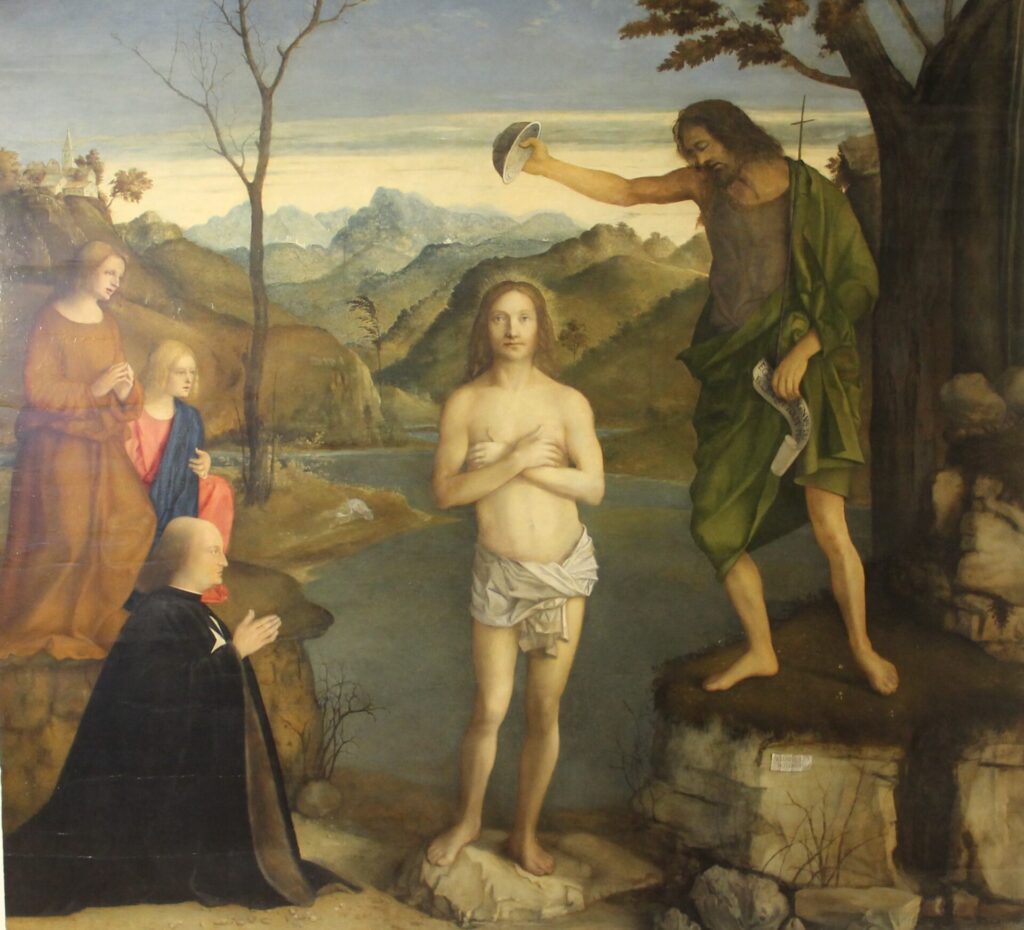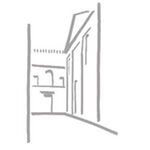
Restoration: Sandra Pesso
Support intervention: Roberto Saccuman
Collaborators in the pictorial integration: Silvia Bonifacio and Barbara Bragato
Supervision of the restoration: Maria Cristina Dossi, Valeria Poletto (works management), Alfeo Michieletto (technical direction) of the Special Superintendence for the Historical, Artistic and Ethno-anthropological Heritage and for the Museum Pole of the City of Venice and the Municipalities of the Lagoon Gronda Scientific analysis: Davide Bussolari (radiography, infrared reflectography, ultraviolet fluorescence), Ornella Salvadori and Enrico Florin, Scientific Laboratory of Mercy, SSPSAE (stratigraphic and XRF sections)
Photographic documentation: Matteo De Fina
Period of intervention: September 2013 – May 2014
Premise
At the beginning of September 2013 the restoration work was started at the premises adjacent to the church, made available by the Grand Priory of Lombardy and Venice, in order to preserve the work in the same environmental context to preserve the structural stability of the wooden support.
In the preliminary phase, in order to conduct the intervention in the most correct way, an accurate investigation was carried out to identify the technical characteristics and evaluate the state of conservation of the work.
The information was acquired through careful observation in normal and grazing light and non-invasive scientific examinations, such as digital radiography, infrared reflectography and ultraviolet fluorescence.
The study was deepened with the help of some stratigraphic sections, to identify the succession of pictorial layers and constituent materials, and microchemical tests to identify the nature of the binders.
Comments on the executive technique:
The work, made on panel, is composed of six poplar axes glued horizontally, near the surface of the joints a camottatura was applied (gluing of a thin band of canvas).
On the entire wooden surface, a layer of gypsum and glue of medium thickness was laid with a finish composed of only animal glue with the function of reducing its absorbency. The subsequent preparatory drawing, particularly appreciable in the shooting in reflectography, was made with the use of cardboard to reproduce the shapes tracing simple and geometric lines to graphite.
Further details have been drawn with thinner lines, sometimes making some changes: for example, it is evident in the face of Christ that the eyes have been moved.
The definitive compositional structure is painted without respecting the drawing, with brushstrokes of color that demonstrate a great mastery of the pictorial technique and numerous changes and second thoughts, clearly evident in radiography: we observe a redefinition of the arms of Christ, the displacement and reworking of the figure of St. John the Baptist, whose face was originally more backward and with a different physiognomy: the outstretched arm with the bowl in his hand was more inclined and close to the figure of Christ. Also from the X-ray it was detected, behind the bidder, the profile of a second figure with a red robe then covered by the figure of virtue standing.
The mixtures based on pigments bound with a drying oil conform to those used by the artist and available on the market of the time: biacca, cinnabar, red earths, ochres and precious colors from the East such as lapis lazuli, used for the sky and for the robe resting on the shoulder of virtue kneeling, the orpiment for the garment of virtue standing, the red lacquers and the green lacquers in the other coats.
State of conservation and previous interventions:
The work has suffered numerous damages and losses already in ancient times with the thinning of the table and the probable modification of the original format. The painting appears reduced both in width, as can be seen from the robes of the figures on the left, partly missing; that in height, as can be seen from the trees that, in the upper margin appear cut.
The X-ray showed a mediocre conservative condition of the pictorial fabric, strongly abraded and with widespread drops of color on the entire surface.
The pictorial layers have undergone various interventions with aggressive cleaning, particularly evident in the complexions and in the landscape that, at the time of the intervention, were covered by four layers of repainting and altered pigmented paints, applied in various eras. Ultraviolet fluorescence shots have located the numerous repaints already recognizable at a first direct observation.
The pictorial film was then covered by thick layers of old pictorial shots, deposits of paints and very altered and dark glues that prevented us from appreciating the colors, volumes and the real nature of the painting.
Restoration work
During the cleaning phase, the trend of the brushstrokes and the imprint of the fingertips used to modulate the consistency of the light color glazes so far hidden under the thick repaints and the multiple ones emerged! strongly altered paints.
The cleaning phase was carried out selectively and gradually according to the most modern methodologies, with the use of diversified materials and procedures: the oxidized and yellowed paints and the most recent restoration retouching have been eliminated with the use of binary mixtures of organic solvents with a predefined composition.
The altered and inhomogeneous coatings of various intensities of dark brown color, based on both protein and oily pigmented substances, were removed with a viscous gel loaded with a chelator with variable pH depending on the needs, which allowed the processing and elimination by thinning of the non-original material in complete safety.
This phase proved to be very laborious both for the thickness and for the discontinuity of the layers. The coatings were probably laid out in order to consolidate and revive the pictorial fabric strongly damaged and consumed by caustic substances used in older cleanings. After the removal of these patinas, a further layer of dark brown appearance emerged, spread in a very uneven way beyond and some very tenacious older repaints, evident in the incarnates, such as in the faces and hands of the figures, which could only be partially removed.
After cleaning, several overlaps of grouting with a slide pattern were highlighted, applied to mask the differences in height between the various cracks of the wood (four types characterized by different color and material), overflowing on the original color, especially near the wood grain, which in the X-ray are black with a horizontal trend.
The overflowing grouting has been eliminated with the mechanical action as well as numerous residues of foreign materials (paper, protein glue, wax and cero-resin) probably added on the occasion of the various consolidations carried out over time.
The aesthetic restitution, carried out in compliance with the state of conservation of the painting, consisted in the balancing of discontinuities by means of light veils of color to recreate a unity of reading, especially in the very abraded faces, in the drapery and in the landscape. The grouting has been reintegrated with the vertical hatching technique, which has allowed in part the reconstruction of the trend of the forms, a very complex work for the breadth and multiplicity of the gaps.
